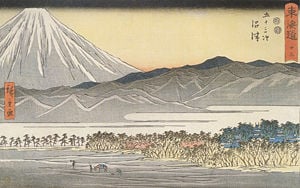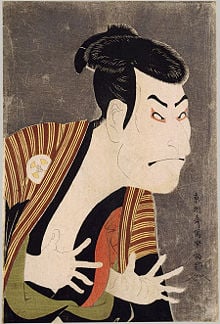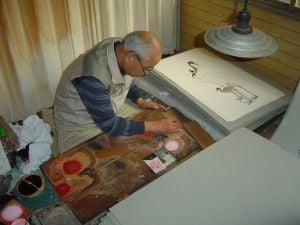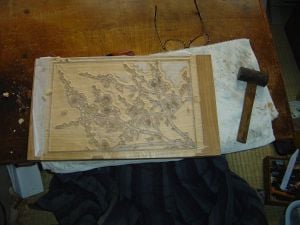Ukiyo-e

Ukiyo-e (浮世絵), "pictures of the floating world", is a genre of Japanese woodblock prints and paintings produced between the 17th and the 20th century, featuring motifs of landscapes, the theater and pleasure quarters.
Ukiyo, meaning "floating world", refers to the impetuous young culture that bloomed in the urban centers of Edo (modern-day Tokyo), Osaka, and Kyoto that were a world unto themselves. It is an ironic allusion to the homophone term "Sorrowful World" (憂き世), the earthly plane of death and rebirth from which Buddhists sought release. The art form rose to great popularity in the metropolitan culture of Edo (Tokyo) during the second half of the 17th century, originating with the single-color works of Hishikawa Moronobu in the 1670s. At first, only India ink was used, then some prints were manually colored with a brush, but in the 18th century Suzuki Harunobu developed the technique of polychrome printing to produce nishiki-e.
Ukiyo-e were affordable because they could be mass-produced. They were meant for mainly townsmen, who were generally not wealthy enough to afford an original painting. The original subject of ukiyo-e was city life, in particular activities and scenes from the entertainment district. Beautiful courtesans, bulky sumo wrestlers and popular actors would be portrayed while engaged in appealing activities. Later on landscapes also became popular. Political subjects, and individuals above the lowest strata of society (courtesans, wrestlers and actors) were not sanctioned in these prints and very rarely appeared. Sex was not a sanctioned subject either, but continually appeared in ukiyo-e prints. Artists and publishers were sometimes punished for creating these sexually explicit shunga.
History
Ukiyo-e can be categorized into several different art periods: the Edo period, which comprises ukiyo-e from its origins in until about 1867, when the Meiji period began and lasted until 1912. The Edo period was largely a period of calm which provided an ideal environment for the development of the art in a commercial form; while the Meiji period is characterized by new influences as Japan opened up to the West.
The roots of ukiyo-e can be traced to the urbanization that took place in the late 16th century which led to the development of a class of merchants and artisans who began writing stories or novels, and painting pictures, compiled together in ehon (絵本, picture books, books with stories and picture illustrations), such as the 1608 edition of Tales of Ise (Ise-monogatari) by Hon'ami Kōetsu. Ukiyo-e were often used for illustrations in these books, but came into their own as single-sheet prints (e.g. postcards or kakemono-e), or were posters for the kabuki theater. Inspirations were initially Chinese tales and artworks. Many stories were based on urban life and culture, guidebooks were also popular, and all in all had a commercial nature and were widely available. Hishikawa Moronobu, who already used polychrome painting, became very influential after the 1670s.

The Kabuki actor Otani Oniji II in the role of Yakko (manservant) Edobe.
In the mid-18th century, techniques allowed for production of full-color prints, called nishiki-e, and the ukiyo-e that are reproduced today on postcards and calendars, date from this period on. Utamaro, Hokusai, Hiroshige, and Sharaku were the prominent artists of this period. After studying European artworks receding perspective entered the pictures and other ideas were picked up. Katsushika Hokusai's pictures depicted mostly landscapes and nature. His Thirty-Six Views of Mount Fuji (富嶽三十六景, Fugaku sanjurokkei) were published starting around 1831. Ando Hiroshige and Kunisada also published many pictures drawn on motifs from nature.
In 1842, and as part of the Tenpo reforms, pictures of courtesans, geisha and actors (e.g. onnagata) were banned. Pictures with these motifs experienced some revival though, when they were permitted again.
During the Kaei era (1848–1854), many foreign merchant ships came to Japan. The ukiyo-e of that time reflect the cultural changes.
Following the Meiji Restoration in 1868, Japan became open to imports from the West, including photography and printing techniques. The natural plant colors used in ukiyo-e were also replaced by chemical aniline dyes imported from Germany. While ukiyo-e, being largely replaced by photography, went out of fashion in Japan during the bunmei-kaika (文明開化, Japan's Westernization movement during the early Meiji period) it became a source of inspiration in Europe for cubism and many impressionist painters, such as van Gogh, Monet, Degas, Klimt, and many others. This influence has been called Japonism.
In the 20th century, during the Taishō and Shōwa periods, ukiyo-e experienced a revival in the forms of the shin hanga and sōsaku hanga movements, both aiming to differentiate themselves from the tradition of commercial mass art. Somewhat ironically, shin hanga, literally new prints, was driven largely by exports to the United States. Inspired by European impressionism, the artists incorporated Western elements such as the effects of light and the expression of individual moods, but focused on strictly traditional themes. The major publisher was Watanabe Shozaburo, who is credited with creating the movement. Important artists included Shinsui Ito and Kawase Hasui, who were named Living National Treasure by the Japanese government.
The less well known sōsaku hanga movement, literally creative prints, followed a Western concept of what art should be: the product of the creativity of the artists, creativity over artisanship. Traditionally the processes of making ukiyo-e, the design, the carving, the printing and the publishing, were separated and done by different and highly specialized people; sōsaku hanga advocated that the artist should be involved in all stages of production. The movement was formally established with the formation of the Japanese Creatice Print Society in 1918, however, it was commercially less successful, as Western collectors preferred the more traditionally Japanese look of shin hanga.
Ukiyo-e are still produced today and are influential in many ways, inspiring, for example, manga and anime.
Making of ukiyo-e
Ukiyo-e prints were made using the following procedure:
- The artist produced a master drawing in ink
- Craftsmen glued this drawing, face-down to a block of wood, cutting away the areas where the paper was white, thus leaving the drawing, in reverse, as a relief print on the block, but destroying the drawing.
- This block was inked and printed, making near-exact copies of the original drawing.
- These prints were in turn glued, face-down, to blocks and those areas of the design which were to be printed in a particular color were left in relief. Each of these blocks prints at least one color in the final design.
- The resulting set of woodblocks were inked in different colors and sequentially impressed onto paper. The final print bore the impressions of each of the blocks, some printed more than once to obtain just the right depth of color.
Important artists
- Hiroshige
- Hishikawa Moronobu
- Hokusai
- Kunichika
- Kunisada
- Sharaku
- Toyokuni
- Utamaro
- Yoshitoshi
Sample ukiyo-e are available on pages of individual artists.
ReferencesISBN links support NWE through referral fees
Further reading
- Lambourne, Lionel. Japonisme: Cultural Crossings Between Japan and the West. London, New York: Phaidon Press, 2005. ISBN 0-7148-4105-6
- Newland, Amy Reigle. The Hotei Encyclopedia of Japanese Woodblock Prints. Amsterdam: Hotei Publishing, 2005. ISBN 90-74822-65-7
- Roni Uever, Susugu Yoshida (1991) Ukiyo-E: 250 Years of Japanese Art, Gallery Books, 1991, ISBN 0-8317-9041-5.
- Yamada, Chisaburah F. Dialogue in Art: Japan and the West. Tokyo, New York: Kodansha International Ltd., 1976. ISBN 0-87011-214-7
External links
- Ukiyo-e in "History of Art"
- History of Ukiyoe
- Kuniyoshi Project
- Gallery with a lot of info
- Overviews of the Printmaking Process detailed description of the stages of printmaking with many illustrations
- Viewing Japanese Prints
- Template:Jaanus
- What is a Print? An excellent flash-demonstration of the printmaking process
- Minneapolis Institute of Arts; Video: Pictures of the Floating World
- Universes in Collision: Men and Women in Nineteenth Century Japanese Prints
- Hokusai Online Exhibition; Freer Gallery of Art and Arthur M. Sackler Gallery, Smithsonian Institute
- http://www.loc.gov/exhibits/ukiyo-e/
- http://learningobjects.wesleyan.edu/blockprinting Ukiyo-E Techniques, an interactive collection of videos and animations demonstrating the techniques of master printmaker Keiji Shinohara.
See also
ar:أوكييو-إه cs:Ukijo-e de:Ukiyo-e et:Ukiyo-e es:Ukiyo-e fr:Ukiyo-e gl:Ukiyo-e it:Ukiyo-e nl:Ukiyo-e ja:浮世絵 pl:Ukiyo-e pt:Ukiyo-e sv:Ukiyo-e fi:Ukiyo-e zh:浮世繪
Credits
New World Encyclopedia writers and editors rewrote and completed the Wikipedia article in accordance with New World Encyclopedia standards. This article abides by terms of the Creative Commons CC-by-sa 3.0 License (CC-by-sa), which may be used and disseminated with proper attribution. Credit is due under the terms of this license that can reference both the New World Encyclopedia contributors and the selfless volunteer contributors of the Wikimedia Foundation. To cite this article click here for a list of acceptable citing formats.The history of earlier contributions by wikipedians is accessible to researchers here:
The history of this article since it was imported to New World Encyclopedia:
Note: Some restrictions may apply to use of individual images which are separately licensed.

